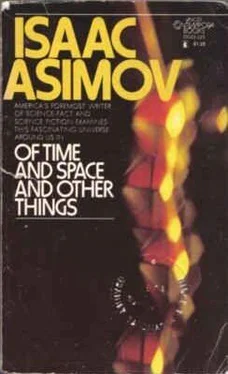Isaac Asimov - Of Time and Space and Other Things
Здесь есть возможность читать онлайн «Isaac Asimov - Of Time and Space and Other Things» весь текст электронной книги совершенно бесплатно (целиком полную версию без сокращений). В некоторых случаях можно слушать аудио, скачать через торрент в формате fb2 и присутствует краткое содержание. Год выпуска: 1972, ISBN: 1972, Издательство: Lancer Books, Жанр: Прочая научная литература, на английском языке. Описание произведения, (предисловие) а так же отзывы посетителей доступны на портале библиотеки ЛибКат.
- Название:Of Time and Space and Other Things
- Автор:
- Издательство:Lancer Books
- Жанр:
- Год:1972
- ISBN:ISBN: 0-447-33023-3
- Рейтинг книги:4 / 5. Голосов: 1
-
Избранное:Добавить в избранное
- Отзывы:
-
Ваша оценка:
- 80
- 1
- 2
- 3
- 4
- 5
Of Time and Space and Other Things: краткое содержание, описание и аннотация
Предлагаем к чтению аннотацию, описание, краткое содержание или предисловие (зависит от того, что написал сам автор книги «Of Time and Space and Other Things»). Если вы не нашли необходимую информацию о книге — напишите в комментариях, мы постараемся отыскать её.
Of Time and Space and Other Things — читать онлайн бесплатно полную книгу (весь текст) целиком
Ниже представлен текст книги, разбитый по страницам. Система сохранения места последней прочитанной страницы, позволяет с удобством читать онлайн бесплатно книгу «Of Time and Space and Other Things», без необходимости каждый раз заново искать на чём Вы остановились. Поставьте закладку, и сможете в любой момент перейти на страницу, на которой закончили чтение.
Интервал:
Закладка:
Fe = q2 (Equation 4)
Let's summarize. We have two objects separated by one centimeter, center to center, each object possessing identi cal charge (positive in one case and negative in the other) and identical mass (no qualifications). There is both a gravitational and an electromagnetic attraction, between them.
The next problem is to determine how much stronger the electromagnetic force is than the gravitational force (or how much weaker, if that is how it turns out). To do * We could make one of them negative to allow for the fact that one object carries a negative electric charge. Then we could say that a negative value for- the electromagnetic force implies an attraction and a positive value a repulsion. However, for our pur poses, none of this folderol is needed. Since electromagnetic at traction and repulsion are but opposite manifestations of the same phenomenon, we shall ignore signs.
this we must determine the ratio of the forces by dividing
(let us say) Equation 4 by Equation 2. The result is:
F, q2 (Equation 5)
F, 0.0000000667 M2
A decimal is an inconvenient thing to have in a denomi nator, but we can move it up into the numerator by taking its reciprocal (that is, by dividing it into 1). Since 1 di vided by 0.0000000667 is equal to 1.5 x 101, or 15,000, 000, we can rewrite Equation 5 as:
F, _ 15,000,000 q2 (Equation 6)
Fg m2 or, still more simply, as:
F,. = 15,000,000 (VM)2 (Equat;on 7)
Since both F, and F, are measured in dynes, then in taking the ratio we find we are dividing dynes by dynes.
The units, therefore, cancel out, and we are left with a "pure number." We are going to find, in other words, that one force is stronger than the other by a fixed amount; an amount that will be the same whatever units we use or whatever units an intelligent entity on the fifth planet of the star Fomalhaut wants to use. We will have, therefore, a universal constant.
In order to determine the ratio 0 the two es, we see from Equation 7 that we must first determine the value of qlm; that is, the charge of an object divided by its mass. Let's consider charge first.
AJI objects are made up of subatomic particles of a number of varieties. These particles fall into exactly three classes, however, with respect to electric charge:
1) Class A are those particles which, like the neutron and the neutrino, have no charge at all. Their charge is 0.
2) Class B are those particles which, like the proton and the positron, carry a positive electric charge. But all particles which carry a positive electric charge invariably carry the same quantity of positive electric charge what ever their differences in other respects (at least as far as we know). Their charge can therefore be specified as +I.
3) Class C are those particles which, like the electron and the anti-proton, carry a negative electric charge.
Again, this charge is always the same in quantity. Their charge is - 1.
You see, then, that an object of any size can have a net electric charge of zero, provided it happens to be made up of neutral particles and/or equal numbers of positive and negative particles.
For such an object q = 0, and no matter how large its mass, the value of qlm is also zero. For such bodies, Equation 7 tells us, FIF, is zero. The gravitational force is never zero (as long as the objects have any mass at all) and it is, therefore, under these conditions, infinitely stronger than the electromagnetic force and need be the only one considered.
This is just about the case for actual bodies. The over all net charge of the Earth and the Sun is virtually zero, and in plotting the EartWs orbit it is only necessary to con sider the gravitational attraction between the two bodies.
Still, the case where F. = 0 and, therefore, FIF,, = 0 is clearly only one extreme of the situation and not a par ticularly interesting one. What about the other extreme?
Instead of an object with no charge, what about an object with maximum charge?
If we are going to make charge maximum, let's first eliminate neutral particles which add mass without charge.
Let's suppose, instead, that we have a piece of matter com posed exclusively of charged particles. Naturally it is of no use to include charged particles of both varieties, since then one " of charge would cancel the other and total charge would be less than maximum.
We will want one object then, composed exclusively of positively charged particles- and another exclusively of negatively charged particles. We can't possibly do better than that as a general thing.
And yet while all the charged particles have identical charges of either + 1 or - 1, as the case may be, they pos sess different masses. What we want are charged particles of, the smallest possible mass. In that case the largest pos sible individual charge is hung upon the smallest possible mass, and the ratio qlm is at a maximum.
It so happens that the negatively charged particle of smallest mass is the electron and the positively charged particle of smallest mass is the positron. For those bodies, the ratio qltn is greater than for any other known object (nor have we any reason, as yet, for suspecting that any object of higher qlm remains to be discovered).
Suppose, then, we start with two bodies, one of which contains a certain number of electrons and the other the same number of positrons. There will be a certain electro magnetic force between them and also a certain gravi tational force.
If you triple the number of electrons in the first body and triple the number of positrons in the other, the total charge triples for each body and the total electromagnetic force, therefore, becomes 3 times 3, or 9 times greater.
However, the total mass also triples for each bod and the y total gravitational force also becomes 3 times 3, or 9 times greater. While each force increases, they do so to an equal extent, and the ratio of the two remains the same.
In fact the ratio of the two forces remains the same, even if the charge and/or mass on one body is not equal to the charge and/or mass on the other; or if the charge and/or mass of one body is changed by an amount different from the charge in the other.
Since we are concerned only with the ratio of the two forces, the electromagnetic and the gravitational, and since this remains the same, however much the number of electrons in one body and the number of positrons in the other are changed, why bother with any but the simplest possible number-one?
In other words, let's consider a Single electron and a simple positron separated by exactly I centimeter. This system will give us the maximum value'for the ratio of electromagnetic force to gravitational force.
It so happens that the electron and the positron have equal masses. That mass, in grams (which are the mass units we are using in this calculation) is 9.1 X 10-28 or, if you prefer, 0.00000000000000000000000000091.
The electric charge of the electron is equal to that of the positron (though different in sign). In electrostatic units (the charge-units being used in this calculation), the value is 4.8 x 10-111, or 0.00000000048.
To get the value qlm for the electron (or the positron) we must divide the charge by the mass. If we divide 4.8 x 10-10 by 9.1 X 10-28, we get the answer 5.3 x 1017 or 530,000,000,000,000,000.
But, as Equation 7 tells us, we must square the ratio qlm. We multiply 5.3 x 1017 by itself and obtain for (qlm)2 the value of 2.8 x 101,1, or 280,000,000,000,000, 000,000,000,000,000,000,000.
Again, consulting Equation 7, we find we must multiply this number by 15,000,000, and then we finally have the ratio we are looking for. Carrying through this multiplica tion gives us 4.2 x 1042, or 4,200,000,000,000,000,000, 000,000,000,000,000,000,000,000.
We can come to the conclusion, then, that the electro magnetic force is, under the most favorable conditions, over four million trillion trillion trillion times as strong as the gravitational force.
Читать дальшеИнтервал:
Закладка:
Похожие книги на «Of Time and Space and Other Things»
Представляем Вашему вниманию похожие книги на «Of Time and Space and Other Things» списком для выбора. Мы отобрали схожую по названию и смыслу литературу в надежде предоставить читателям больше вариантов отыскать новые, интересные, ещё непрочитанные произведения.
Обсуждение, отзывы о книге «Of Time and Space and Other Things» и просто собственные мнения читателей. Оставьте ваши комментарии, напишите, что Вы думаете о произведении, его смысле или главных героях. Укажите что конкретно понравилось, а что нет, и почему Вы так считаете.












